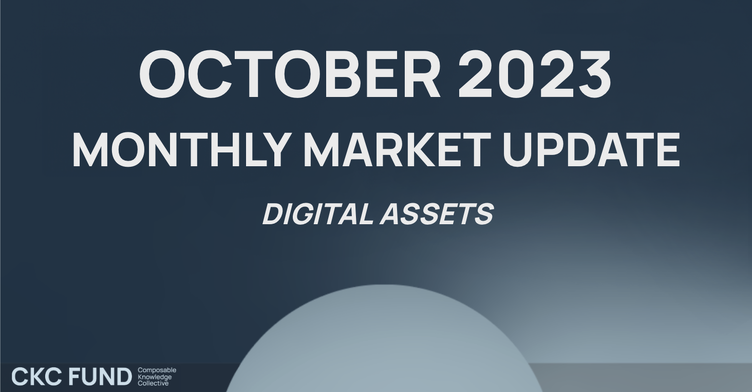Key Takeaways
🚀 "Uptober" for BTC: October records a +27.2% increase in BTC price.
📊 Market Sentiment: Anticipated approval of BTC spot ETF propels a 10% rally.
🏗️ Market Structure: BTC shows strong holding patterns and a lower stock market correlation.
💹 ETH Performance: ETH rises 8.5%, yet falls behind BTC, with slowed network activity.
🌐 Blockchain Updates: Taproot Assets debut and Uniswap introduces swap fees.
📧 Stay updated via CKC.Fund on LinkedIn or contact info@ckc.fund
The month of October has earned the nickname 'Uptober' among cryptocurrency enthusiasts due to its consistent record of boosting Bitcoin's (BTC) value. Historical data reveals that, in the last decade, including 2023, Bitcoin's price has risen during October in 8 out of 10 instances, with the exceptions being 2014 and 2018. Specifically, in October 2023, anticipatory buzz surrounding the possibility of a Bitcoin spot ETF being sanctioned in the United States led to a remarkable 27.2% surge in Bitcoin's price over the month.
While the Securities and Exchange Commission (SEC) has not officially confirmed any ETF approvals, investor sentiment strongly suggests that an endorsement is on the horizon. This sentiment was particularly evident after Bitcoin's significant leap on October 23rd and its ongoing robust price performance, which included a dramatic 10% increase overnight. This was sparked by an erroneously published report claiming that BlackRock's iShares Bitcoin Trust had been registered on the Depository Trust & Clearing Corporation (DTCC) with the ticker symbol $IBTC, a report that was later retracted. Even though this news did not have a direct impact on the approval of a BTC spot ETF, Bitcoin has managed to hold onto its gains, hinting that the market had not fully anticipated the approval.

Has the Market Structurally Changed?
Price increases have not swayed the commitment of long-standing Bitcoin investors. The market value to realized value (MVRV) ratio, a key on-chain metric for assessing market cycles and investor sentiment, saw a 21.6% rise in October, reaching a value of 1.7. This ratio is instrumental in analyzing the state of the market, with a higher MVRV suggesting a potential peak, and a lower MVRV typically signaling a market bottom or a period of asset accumulation.

Conversely, Bitcoin's market capitalization dominance has been on a steady incline over the year, now capturing 51% of the market. Concurrently, the ETH/BTC ratio has dipped to the lowest value of the year at 0.052, which underscores Bitcoin's sustained dominance. These metrics are crucial indicators for predicting a possible shift in trends or a reallocation of investment into alternative cryptocurrencies.
Bitcoin's market capitalization dominance has been on a steady incline over the year, now capturing 51% of the market.
Moreover, Bitcoin has recently exhibited a notable separation from traditional stock markets. Its 90-day correlation with the Nasdaq Composite Index has decreased significantly, dropping from 53.8% to 22.5% year-to-date. However, despite this reduced correlation, the possibility of a shift to risk-averse investment strategies due to escalating geopolitical tensions could influence market movements in the upcoming months.

In the midst of Bitcoin's robust performance, Ethereum (ETH) posted a respectable monthly increase of 8.5%. However, the ETH/BTC ratio experienced a 15.5% decline, perpetuating the downtrend that began in October of the previous year. Contrasting with the substantial capital influx observed in Bitcoin-related Exchange Traded Products (ETPs), Ethereum ETPs experienced withdrawals, though the outflow was less pronounced compared to earlier months.
On the Ethereum network itself, there was a noticeable deceleration in on-chain activity, which resulted in a 5.9% reduction in the average transaction fees throughout October. Despite a 4.9% increase in the amount of total staked ETH over the month, the growth rate has been losing momentum, evident from a three-month streak of slowing pace.
Blockchain Applications Updates
Lightning Labs, a key player in Bitcoin's Layer-2 solutions, has introduced the mainnet alpha release of its Taproot Assets protocol, designed to simplify the process of creating and managing stablecoins and real-world assets on the Bitcoin and Lightning Network. The latest iteration, Taproot Assets v0.3, is crafted to provide developers with an extensive toolkit for the issuance and administration of various digital assets on the Bitcoin ledger.
In a strategic move within the decentralized finance (DeFi) space, Uniswap Labs, renowned for its decentralized exchange services, implemented a 0.15% fee for trading certain crypto assets via its interface on October 17th. This marked the platform's inaugural fee imposition, which led to a notable revenue of $400,000 in the first week. This move has initiated intense discussions around the business models in open applications and the allocation of generated value within the DeFi protocols. Particularly, the accrued fees benefit Uniswap Labs rather than the token holders, which has had a discernible impact on the performance of the UNI token. This situation has become a focal point for other protocols in the industry, stimulating debates over the adoption of revenue models and the identification of the most effective layer within the technology stack to enforce them.

Following the surge in the broader cryptocurrency market, the collective market capitalization of decentralized finance (DeFi) assets has reached a peak not seen in three months. Moreover, the total value locked (TVL) in DeFi protocols has crossed $41.9 billion, a milestone last achieved in August. While the spotlight has predominantly been on Bitcoin and the potential ETF by BlackRock, an array of DeFi and GameFi assets have been surpassing Bitcoin in terms of performance with less fanfare.
Assets such as DYDX, AAVE, AXS, and THOR have demonstrated significant growth, recording increases of 25%, 32%, 28%, and 41% respectively in the final week of October. These figures highlight the robust performance of select DeFi and GameFi assets, which may be flying under the mainstream radar amidst the focus on Bitcoin's movements and institutional developments.
Navigating the complex and ever-changing world of digital assets can be a challenge, but staying informed is key. If you found value in these insights and wish to deepen your understanding of this evolving space, consider connecting with CKC.Fund on LinkedIn. Additionally, if you aren’t already, you can subscribe to our newsletter, filled with tailored digital asset insights. For more personalized guidance, reach out at info@ckc.fund. Connecting with us helps you stay one step ahead in the world of digital assets.
This content is intended for general informational purposes only. CKC.Fund does not render or offer personalized financial, investment, tax, legal, security, or accounting advice. The information provided in this content is provided solely as general information and to provide general education. No information contained herein should be regarded as a suggestion to engage in or refrain from any investment-related course of action. This content may contain certain statements, estimates and projections that are "forward-looking statements." All statements other than statements of historical fact in this content are forward-looking statements and include statements and assumptions relating to: plans and objectives of management for future operations or economic performance; conclusions and projections about current and future economic and political trends and conditions; and projected financial results and results of operations. These statements can generally be identified by the use of forward-looking terminology including "may," "believe," "will," "expect," "anticipate," "estimate," "continue", "rankings," “intend,” “outlook,” “potential,” or other similar words. CKC.Fund does not make any guarantees, representations or warranties (express or implied) about the accuracy of such forward-looking statements. Forward-looking statements involve certain risks, uncertainties, and assumptions and other factors that are difficult to predict. Viewers are cautioned that actual results referenced in this content could differ materially from forward-looking statements; and viewers of this content are cautioned not to view forward-looking statements as actual results or place undue reliance on forward-looking statements. Past performance is not indicative nor a guarantee of future results. No content in this content shall be viewed as a guarantee of future performance.

